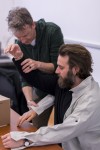A Nikon 360-degree camera stood on a tripod, unattended, in the middle of Bruin Plaza.
Anisa Bashiri and three of her classmates observed students passing the camera without a second glance.
Only a few students, of the hundreds on Bruin Walk, reacted to the camera in the 30 minutes that it filmed them. The other students, occupied with their phones or busy in conversation, seemed unaffected by its presence, Bashiri said.
“We were really interested in playing with the idea of surveillance because we live in a time when cameras are everywhere, and we don’t even know they exist and are documenting our presence,” said the fourth-year Design | Media Arts student.
Projects like Bashiri’s, which use technology to tackle real-world issues like surveillance, are the norm in UCLA Game Lab lecturer Daniel Landau’s Design | Media Arts class, “Topics in Video and Animation: Art and Science of Virtual Reality,” this quarter.
Born in Jerusalem, the Israeli artist is visiting UCLA to teach this quarter and to showcase his “Time-Body Study,” a virtual reality presentation, on Tuesday at the Broad Art Center.
[Related: UCLA computer science class integrates virtual world into reality]
Landau’s work focuses on how technology can affect the human race on an emotional level. His “Time-Body Study” performative experiment demonstrates the adaptability of the human mind in response to its technological environment.
At the presentation, participants will be chosen from the audience to demonstrate the effects that virtual reality technology can have on the mind.
Participants in Landau’s presentation cognitively believe they are in the body of a 7-, 40- and 80-year-old person by using a headpiece programmed with virtual reality technology.
The illusion is known as re-embodiment. The effect places the participant in a virtual world, which is also projected on a screen for the audience to see.
A presenter creates a physical illusion by touching a participant’s hands at the same time that the participant sees his or her virtual hands being touched through the headpiece, syncing the two worlds.
The presentation shows modern technology can impact humans’ mentalities.
Landau provides narration throughout the presentation to explain that virtual reality technology allows for manipulation of the human mind, which will adapt to the technological environment it perceives.
“It raises a lot of questions regarding how our identity, and the relationship between our body and our identity, is a very fluid construct actually,” Landau said.
Landau continues the discussion of the effects of technology on the human race in his class by teaching students how to use virtual reality and then giving them creative freedom to conduct their own projects, Bashiri said.
[Related: Student’s project seeks to create game experience mimicking poetry]
UCLA’s Y&S Nazarian Center for Israel Studies worked with the Israel Institute to bring Israeli educators like Landau to campus. Landau stood out to Maura Resnick, deputy director of the Y&S Nazarian Center, for being a charismatic, well-spoken and innovative researcher in technology, she said.
“His work is rather interdisciplinary, in that he is very interested in the relationship between art and science, and art and technology,” Resnick said. “We found that fascinating and wanted to share it with UCLA students.”
Fourth-year Design | Media Arts student Elena Dick is among one of the students enrolled in Landau’s class. Previously, her only experience with virtual reality was at a small pub in London while she was on break. Inside the bar, a virtual reality video game about slaying zombies charged a fee for 15 minutes of play, she said.
When she later discovered that Landau was offering a virtual reality class, Dick said she was excited to experience the technology again and to learn about how it is made.
“It’s such a niche industry, I wouldn’t have the opportunity to learn it on my own,” Dick said.
Kayla Eber, a third-year Design | Media Arts student, took Landau’s class because she believes virtual reality is the technology of the future.
Landau’s class details the history of virtual reality technology and how it has improved over the years. It looks at past experiments as well as students’ own projects that utilize virtual reality technology, Eber said.
“I like to see the story of mankind as the story of the tools he has created,” Landau said. “It’s the most dramatic story in mankind.”
